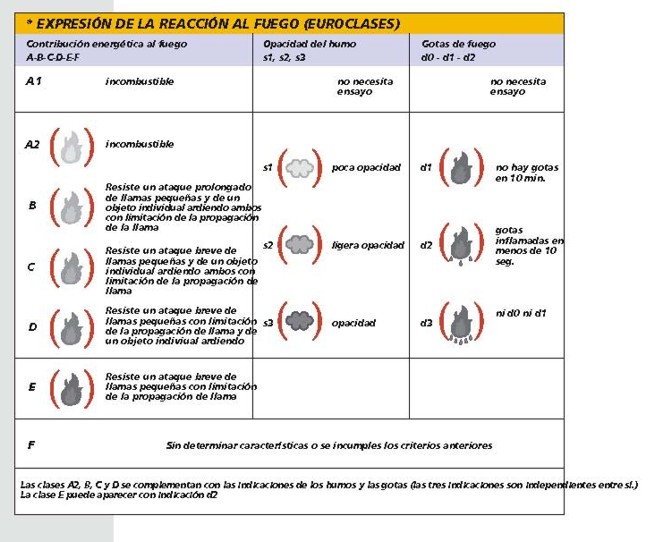Reaction to Fire of Sandwich Panels According to Euroclasses
The European Euroclass standard evaluates the fire performance of materials, including sandwich panels, and their contribution to fire propagation. This classification is essential to ensure safety in construction and facilitates uniformity in the use of materials within the European Union. Below, we detail how sandwich panels are classified according to their fire resistance and other criteria:
Energy Contribution to Fire (Classes A1, A2, B, C, D, E and F)
- A1: Non-combustible sandwich panels that do not contribute to the development of fire under any circumstances. They do not require additional smoke or flaming droplet tests.
- A2: Virtually non-combustible sandwich panels, with behavior similar to A1 but with minimal impact on fire.
- B: Sandwich panels that resist prolonged attack by small flames and significantly limit the spread of fire.
- C: Sandwich panels that resist a brief attack of small flames, although with less limitation in the spread of fire than class B.
- D: Sandwich panels with limited fire resistance, allowing greater propagation.
- E: Sandwich panels with basic fire resistance, which can easily catch fire.
- F: Sandwich panels without classification or not meeting the minimum criteria.
Smoke Opacity (s1, s2, s3)
In sandwich panels, smoke generation is classified into three levels:
- s1: Low opacity, smoke generated is low and does not significantly affect visibility.
- s2: Slight opacity, smoke is moderate and could hinder visibility in certain conditions.
- s3: High opacity, smoke is dense and can seriously obstruct visibility.
Swollen Drops (d0, d1, d2)
Sandwich panels are also evaluated for the flaming droplets or particles they generate when burning:
- d0: No swollen drops in 10 minutes.
- d1: Flaming droplets, but with limitations (less than 10 seconds of ignition).
- d2: Generates unrestricted swollen droplets.
Interpretation of the Classes in the Sandwich Panels
The classification of sandwich panels under the Euroclasses can be combined with indications of smoke opacity (s1, s2, s3) and flaming droplets (d0, d1, d2). For example:
- A sandwich panel classified as B-s1-d0 means:
- High fire resistance (class B).
- Generates little smoke (s1).
- It does not produce swollen drops (d0).
Importance of Sandwich Panel Grading
Classification under the Euroclasses is essential to ensure:
- Increased building security.
- European regulatory compliance.
- Ease of technical specification in construction projects using sandwich panels.
At Starmodul, we work with sandwich panels that comply with the most demanding standards, offering safe, reliable solutions adapted to the specific needs of our customers.
If you need more information about sandwich panels and their fire classification or how we apply these regulations to our products, please contact us.

European Fire Regulations: Safety and Conformity in the Use of Sandwich Panels
At Starmodul, we are committed to quality and safety, offering sandwich panels that meet the highest standards of fire resistance. Our priority is to ensure that our building systems and sandwich panels comply with European fire regulations, providing peace of mind and confidence in every project.
What is the European fire regulation?
The European fire standard establishes clear guidelines for assessing and classifying the fire performance of materials, such as sandwich panels. Its main objective is:
- Protect human life: Ensure that buildings constructed with sandwich panels provide sufficient time for safe evacuation in case of fire.
- Reduce property damage: Limit the spread of fire and minimize structural damage.
- Facilitate emergency response: Create safer environments for rescue and firefighting teams.
European fire resistance classification
European standards use the Euroclass system (EN 13501-1) to classify sandwich panels according to their fire performance, taking into account:
- Reaction to fire: Ability of the sandwich panel to contribute or not to the spread of fire. It is classified from A1 (non-combustible) to F (no classification).
- Fire resistance: Time during which the sandwich panel retains its functionality against high temperatures. This includes:
- A: Structural load capacity.
- E: Integrity against the passage of flames and gases.
- I: Thermal insulation to prevent heat transmission.
For example, an REI 60-rated sandwich panel can maintain its strength, integrity and thermal insulation for 60 minutes.
How it is applied to Starmodul sandwich panels
At Starmodul, we design and market sandwich panels that comply with the most demanding European standards, guaranteeing:
- Certified materials: We work with sandwich panels tested under the strict requirements of the Euroclasses.
- Tests and validations: Our panels have been evaluated in accredited laboratories under real fire conditions.
- Safe design: We offer sandwich panels with optimum fire resistance properties, suitable for any construction project.
Advantages of complying with European fire regulations with sandwich panels
- Certified reliability: We guarantee that our sandwich panels meet the strictest standards.
- Enhanced security: Effective protection for people and property.
- International compatibility: Our panels comply with export regulations and local requirements throughout Europe.
Commitment to safety
At Starmodul, we not only optimize your sandwich panel construction, but we also prioritize safety at every stage. We work to ensure that our products comply with the most stringent regulations, adapting to your specific needs without compromising quality or durability.
If you need more information on how our sandwich panels comply with European fire regulations or are looking for advice for your project, please do not hesitate to contact us. At Starmodul, we are here to help you build safely, efficiently and with the best materials.

